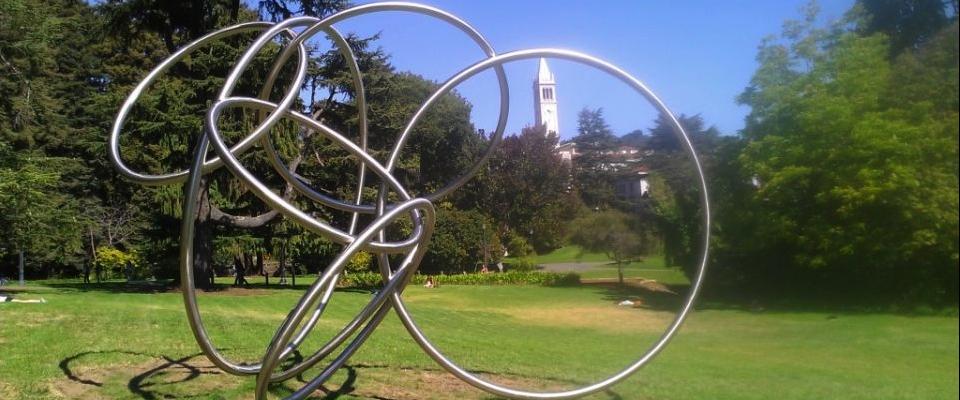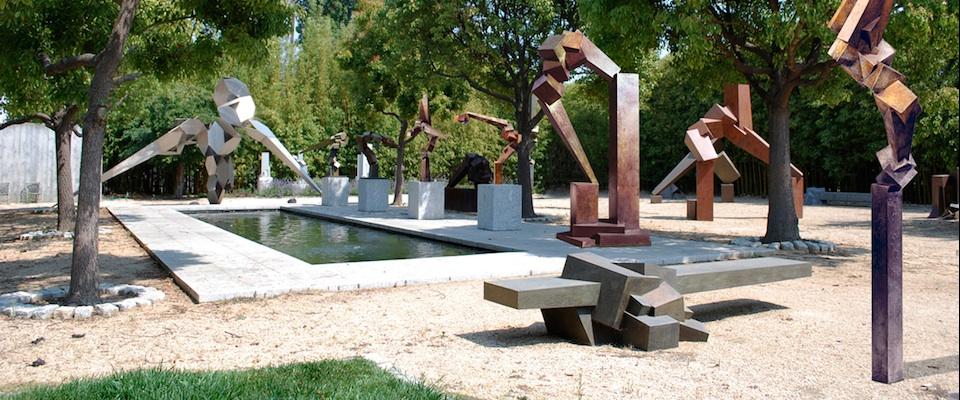Centered over the reflective pool outside the Hearst Memorial Mining Building on the UC Berkeley campus, Bruce Beasley’s newest sculpture seems to skim the surface of the water, without quite touching it. The piece, an apparently spontaneous jumble of intersecting metal rings, has a surprisingly ethereal quality for a 1,500-pound tangle of stainless steel.
“Like all good art, I wanted it to feel easy,” Beasley explains, standing in one of the cavernous workspaces that make up the block-spanning residential and creative complex that he’s gradually expanded since graduating from Berkeley in 1962 and moving to West Oakland’s Lower Bottoms neighborhood. “If dance, which is of course exceedingly difficult and precise, looks hard, it isn’t beautiful to watch.”
“The goal was to make it feel as though the rings just came together.”
Of course, these rings didn’t just come together. Rondo II, which was installed on submerged stilts over the pool earlier this month, is the product of five months of geometrically meticulous design, 3D-printer prototyping, metalworking, polishing, and plenty of trial and error.
Beasley says it takes a tremendous amount of perseverance and focus to make something look extemporaneous. But “extemporaneous” was the goal from the outset—and this marks the first time in his five-decade career that Beasley started a project with such a specific goal. “For decades I’ve struggled with the fact that large-scale sculptures often conflict with the feeling of the surrounding environment,” he says. “So I set myself a research project: can I develop a vocabulary that is large enough to stand out and which contrasts with its surroundings, but which is friendly with the landscape.”
To clarify, by “research,” Beasley doesn’t mean diving into books, but making sculptures that don’t work—over and over and over—until one finally does.
And so after a year of hands-on study to find the perfect combination of size, material, and form, he finally settled on Rondo. Instead of blocking out or dominating the surroundings, Beasley’s rings frame it, he says. The abraded pattern on the metal makes sunshine, moonlight, and the reflection off the water pop off the ring.
“I want the piece to hold its own,” he says. “But the idea is also that the piece embraces the landscape, [rather than] intrude on it. That the environment becomes part of the sculpture.”
Beasley will be able to test that idea in five settings around the campus. Working in collaboration with the University’s landscape architect, Jim Horner, Beasley is producing the five-piece Rondo series to be exhibited all across the campus. According to Horner, this is the first time in Berkeley’s history that a single-artist series is getting the campus gallery treatment.
Beasley fled the “social self-satisfaction” of Dartmouth in 1959 to study sculpture at Berkeley, and by all accounts played a major role in catapulting the school’s art department into the international leagues. So this homecoming “feels right” to him. “Berkeley very much shaped my career: my tendency to play with and invent new technologies, to take on new challenges, to always strive to learn new things,” he says.
“The campus is so famous for business, law, and the sciences, but I do hope this will highlight the cultural output of Berkeley,” he says. “Especially now, when there is such a focus on the hard sciences, on things that are a bit easier to put your finger on, I think that’s a useful reminder.”





















